Rowan intermediate and its cultivation

Rowan intermediate is an excellent addition to landscape design and decoration of the site. This hybrid species is mainly found in Eastern and Central Europe, as well as in the Scandinavian countries. Due to the fact that it tolerates frost and cold well, it can be grown in Russia. Here he takes root well and does not die.
general description
The intermediate rowan is a beautiful tree that grows up to 10 meters in height. This tree has a second name - Swedish mountain ash. It is notable for the fact that it does not require constant self-care, and the fruits obtained are many times tastier than that of ordinary mountain ash. The formation of the crown of this tree occurs independently, but if you make your own adjustments in the form of pruning, the mountain ash will also acquire a decorative character.
Rowan flowers appear at the end of May and last until June. During this period, there is a pungent, but pleasant smell. The flowers themselves look pretty pretty. They are white and gathered in bunches. Egg-shaped leaves are pale green in color, and grayish at the bottom. The yellowing period begins in October, and then the tree acquires extraordinary beauty: bright fiery berries against the background of a golden crown.
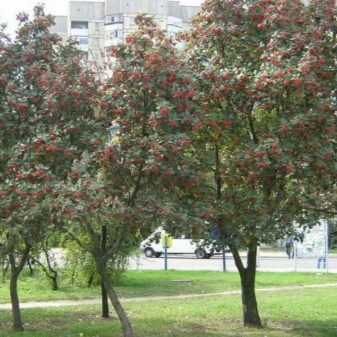
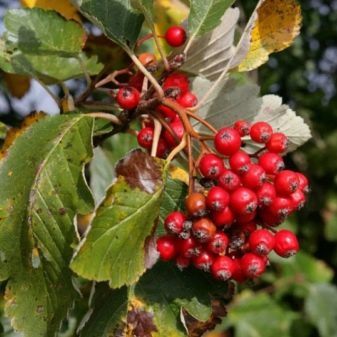
Landing
Planting mountain ash is very easy and simple. The main thing is to adhere to the correct sequence. After all, adherence to the algorithm is the key to future success.
Dates and choice of location
If you buy a rowan seedling in a nursery, then do it in such a way as to plant it right away. That is, the purchase should be made either in the spring or in the fall. It is recommended to plant rowan in spring from March to early April, and in autumn - in early October., since at this moment the future tree has not yet had time to start growing.
It is also necessary to correctly and competently choose the landing site. It is best to plant in an area where the soil is fertile and the acidic environment is neutral. Please note that such a mountain ash loves large, spacious and light areas. But if there is any small shadow, then there is nothing to worry about.
Groundwater will be harmful to the tree, so plant it away from it. If this is not possible, then the soil must be drained.
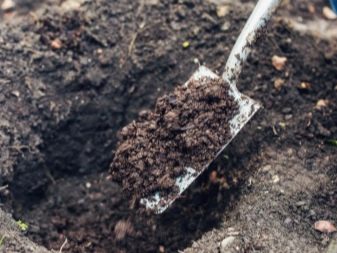
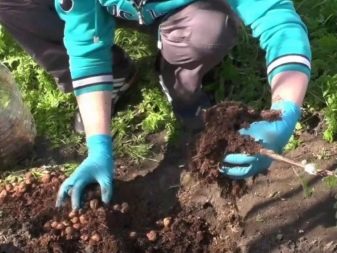
Preparation
In order for the mountain ash to please your eye for a long time and does not require much effort in care, you need to choose the right seedling. To do this, rely on the following criteria:
- the bark should be smooth, without any cracks and damage, as in the future this can adversely affect the growth and health of the tree;
- the seedling must be at least 2 years old;
- healthy root branches are important.

Technology
You need to dig a hole about 80-90 centimeters deep. This is an average value, since it all depends on the size of the root system. Over time, the roots will grow larger and larger, so the width of the hole should be at least one meter so that they have room to grow. At the bottom, a dug hole is usually loosened by 20 centimeters. And then drainage is laid. If you plan to plant several trees in a row, then you should maintain a distance of 8 meters between the holes so that the rowan trees are comfortable to grow.
As a fertilizer, ash and superphosphate are poured into the planting site. It is also good to add dung. After that, the plant is placed in the center in a hole, the long roots must be cut off. When backfilling, make sure that the root collar is above the ground. Further, abundant watering is required.
Make the landing cusp. Then cover the excavated area with a layer of mulch: in winter it will protect the roots from frost, and in the warm season it will begin to retain moisture to avoid rapid evaporation. Also, thanks to her, there will be fewer weeds, and they will grow many times slower.

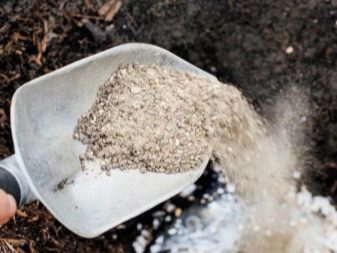
Care
Rowan care is quite simple. From time to time you need to water it, weed it from weeds. It is also necessary to apply mineral and natural fertilizers. Let's consider all this in more detail.
Regular watering is very necessary for the plant. Abundant irrigation should be applied during drought and extreme heat so that the soil does not dry out. Thanks to the mulching done, moisture will remain longer near the roots of the plant, which means that watering can be done less often. As mulch, straw, sawdust and everything like that are suitable.
It is advisable to feed mountain ash no earlier than 3 years after it was planted. In the spring, a mixture of potassium salt, nitrogen and phosphorus fertilizers is used for feeding. And in the fall they give a potassium mixture, as well as phosphorus. After fertilization, the soil is dug up to a depth of 15 cm. Then a large amount of water is added.
Any cultivated plant must be cut, but this must be done strictly according to certain rules so as not to harm the tree. Pruning correctly will increase fruiting and help prevent many possible diseases. It is preferable to do this in the summer, since the mountain ash will transfer the process more easily.


The best time for the procedure is a clear and dry day. At this moment, the likelihood of the introduction of fungal diseases is less. It is very important to use tree putty for every cut you make.
At the intermediate rowan, it is necessary to cut off the lower branches located 0.5 m from the ground. The conductor is usually cut so that it is 20 cm longer than the skeletal branches. By sticking to this method, you will get a formative crown pruning. A new growth of shoots will also begin. The autumn season is undesirable for this procedure due to the fact that the tree begins to prepare for winter, and with pruning this process will be weaker. The rowan can freeze.
If pruning in the summer is not very convenient for you, then an alternative option for you would be to perform it in February. But this method can only be used for trees from 4 years old. This is because they already have frost resistance. Weak, broken branches should be pruned during this period. You also need to remove any sticking out and deformed branches. It is desirable to thin out thickened branches. And if your tree has poor growth, then you need to apply rejuvenation pruning.
It is necessary to fight against root shoots in a timely manner. As a preventive measure, they usually harrow the soil to a depth of at least 8 cm.
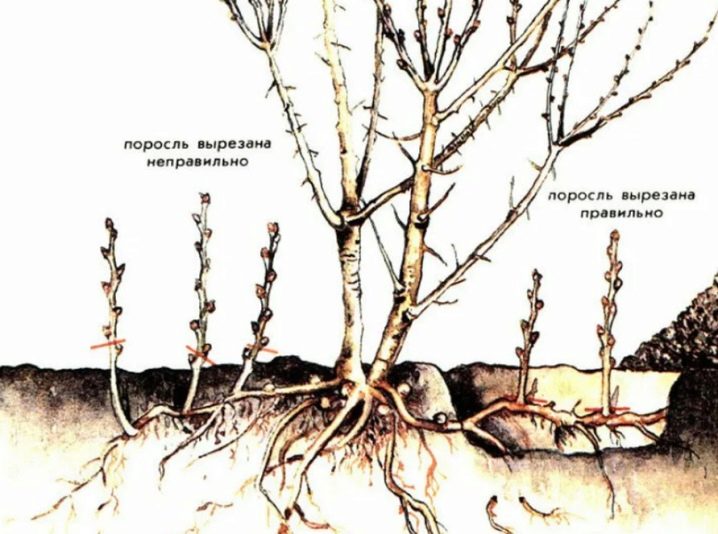
Reproduction
Reproduction will work best if done in the spring season. And if you live in the southern regions, then you can propagate the tree at the end of September - beginning of October. This mountain ash has several breeding methods. You can do everything according to the standard: cuttings or seeds. And you can go differently, in a more unconventional way: with the help of layering and root growth.
In order to use the second method, you need to complete the following points.
- Dig up and clear the ground from all kinds of weeds and various debris. Digging must be done in the trunk circle.
- Next to a long rowan branch, a small and shallow ditch should be dug.
- Bend the selected branch to the ground and secure it with metal staples.
- Next, you need to wait a certain amount of time for new shoots to appear on the branch.
- Cover the resulting layer with humus and soil in proportions 1: 1.
- You can separate the layers the next year. After separation, transplant it to its permanent place of growth.
Note that sometimes growth appears in the trunk circle.It can be separated from the mother tree and transplanted into the place you need.

Diseases and pests
Swiss mountain ash has good resistance to attacks of harmful insects and to various diseases and infections. But still, there are times when the immune system of a tree weakens and fails, so in some years you can notice various diseases and pests.
The most common diseases are scab, powdery mildew, phomosis, septoria, rust and wood rot. And from insects, caterpillars, aphids, ticks and sawflies can cause damage. To overcome all these ailments, it is advised to use special chemicals. You can also use folk methods, because they are also quite effective.
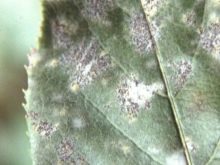

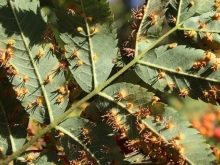
Use in landscape design
If you have long wanted to add some variety to the design of your front garden, then the Swedish mountain ash will be an excellent option for this. It will fit perfectly and blend in with the rest of the plants in any garden. The value of the tree lies in the fact that it looks unusual because of the leaves that look like oak, and because of the red-orange berries that give it its variegation.
There are several interesting options for the location of this tree. Let's consider each of them.
- Rows. Along any path, path or even along the perimeter of the site, it will be good to plant this tree in one continuous row.
- Single landing. This method is suitable for adding a bright accent spot that will harmoniously look both in the very center of the site and somewhere near the fence. Planting options for one tree can be listed forever, so rely on your taste and do as you see fit.
- Territory near the house. If you do not have a separate site, then you can plant an intermediate rowan on the lawns near your house. Even the neighbors will appreciate this solution.
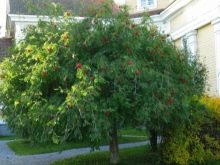
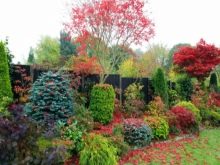
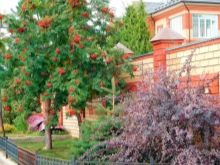



































































The comment was sent successfully.